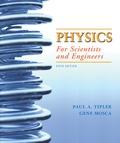
(a)
The comparison of total energy stored in the two capacitors.
(a)
Answer to Problem 118P
The comparison of total energy stored in the two capacitors is
Explanation of Solution
Formula Used:
The expression for the charge on the capacitor is given by,
The expression for the potential of the capacitor of the final stage.
The expression for the total charge on the capacitor is given by,
The expression for the initial energies stored in the capacitor is given by,
The expression for the final energies stored in the capacitor is given by,
The expression for the charge
The expression for charge
Equation (II) can be re written as,
The expression for the ratios of initial and final energies is given by,
Conclusion:
Therefore, the comparison of total energy stored in the two capacitors is
(b)
The current through
(b)
Answer to Problem 118P
The current through
Explanation of Solution
Formula Used:
The expression for the current passing through the circuit is given by,
The expression Kirchhoff’s loop rule to circuit when the switch is at
The expression for the law of the charge on the capacitors is given by,
Equation (III) can be re written as,
Let the solution for the differential equation (IV) be,
So,
Equation (IV) can be rewritten as,
Compare with solution of the equation.
And,
From the initial condition,
The solution of the differential equation is,
The current in the circuit is given by,
Conclusion:
Therefore, the current through
(c)
The energy delivered to resistor as a function of
(c)
Answer to Problem 118P
The energy delivered to resistor as a function of
Explanation of Solution
Formula Used:
The current through
The expression for the energy dissipated through the resistor is given by,
Conclusion:
Therefore, the energy delivered to resistor as a function of
(d)
The total energy dissipated.
(d)
Answer to Problem 118P
The total energy dissipated is
Explanation of Solution
Formula Used:
The expression for the energy dissipated through the resistor is given by,
The expression for the total energy dissipated through the resistor is given by,
Conclusion:
Therefore, the total energy dissipated is
Want to see more full solutions like this?
Chapter 25 Solutions
Physics for Scientists and Engineers
- 3. If the force of gravity stopped acting on the planets in our solar system, what would happen? a) They would spiral slowly towards the sun. b) They would continue in straight lines tangent to their orbits. c) They would continue to orbit the sun. d) They would fly straight away from the sun. e) They would spiral slowly away from the sun. 4. 1 The free-body diagram of a wagon being pulled along a horizontal surface is best represented by A F N B C 0 Ꭰ FN E a) A b) B c) C app app The app 10 app d) e) ס ח D E 10 apparrow_forwardPls help ASAParrow_forwardPls help asaparrow_forward
- Pls help asaparrow_forwardThe acceleration of an object sliding along a frictionless ramp is inclined at an angle 0 is 9. a) g tano b) g cose c) g sino 10. d) g e) zero A 1.5 kg cart is pulled with a force of 7.3 N at an angle of 40° above the horizontal. If a kinetic friction force of 3.2 N acts against the motion, the cart's acceleration along the horizontal surface will be a) 5.0 m/s² b) 1.6 m/s² c) 2.4 m/s² 11. d) 1.0 m/s² e) 2.7 m/s² What is the net force acting on an object with a mass of 10 kg moving at a constant velocity of 10 m/s [North]? a) 100 N [North] b) 100 N [South] 10 N [North} d) 10 N [South] e) None of these.arrow_forwardModified True/False - indicate whether the sentence or statement is true or false. If the statement is false, correct the statement to make it true. 12. An object in uniform circular motion has a constant velocity while experiencing centripetal acceleration. 13. An object travelling in uniform circular motion experiences an outward centrifugal force that tends to pull the object out of the circular path. 14. An object with less inertia can resist changes in motion more than an object with more inertia. 15. For an object sliding on a horizontal surface with a horizontal applied force, the frictional force will always increase as the applied force increases.arrow_forward
 Physics for Scientists and Engineers: Foundations...PhysicsISBN:9781133939146Author:Katz, Debora M.Publisher:Cengage Learning
Physics for Scientists and Engineers: Foundations...PhysicsISBN:9781133939146Author:Katz, Debora M.Publisher:Cengage Learning Glencoe Physics: Principles and Problems, Student...PhysicsISBN:9780078807213Author:Paul W. ZitzewitzPublisher:Glencoe/McGraw-Hill
Glencoe Physics: Principles and Problems, Student...PhysicsISBN:9780078807213Author:Paul W. ZitzewitzPublisher:Glencoe/McGraw-Hill Principles of Physics: A Calculus-Based TextPhysicsISBN:9781133104261Author:Raymond A. Serway, John W. JewettPublisher:Cengage Learning
Principles of Physics: A Calculus-Based TextPhysicsISBN:9781133104261Author:Raymond A. Serway, John W. JewettPublisher:Cengage Learning
 College PhysicsPhysicsISBN:9781305952300Author:Raymond A. Serway, Chris VuillePublisher:Cengage Learning
College PhysicsPhysicsISBN:9781305952300Author:Raymond A. Serway, Chris VuillePublisher:Cengage Learning College PhysicsPhysicsISBN:9781285737027Author:Raymond A. Serway, Chris VuillePublisher:Cengage Learning
College PhysicsPhysicsISBN:9781285737027Author:Raymond A. Serway, Chris VuillePublisher:Cengage Learning





